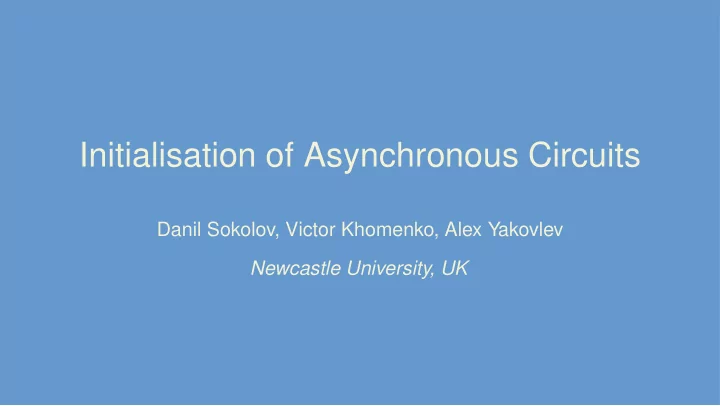

Initialisation of Asynchronous Circuits Danil Sokolov, Victor Khomenko, Alex Yakovlev Newcastle University, UK
Introduction Speed-independent (SI) synthesis does not insert reset logic • Initialisation phase does not have to be SI • Initialisation via an externally generated reset signal (e.g. active-low) • reset is initially low, sufficiently long to complete initialisation of all gates • reset eventually goes high and normal SI operation begins • reset stays high for the whole time of circuit normal operation • Ways to initialise a circuit (can be used in combination) • Rely on the initial state of some of the inputs • Substitute some gates with “resetable” alternatives • Insert additional gates to explicitly initialise the internal and output signals • (they act as buffers during normal operation, so be careful with isochronic forks) Need for design automation • 2 / 11
Circuit initialisation in W ORKCRAFT Init to one property (Boolean flag) • Defines the expected initial state of the signal • Automatically assigned if a circuit is synthesised by one of the backend tools • Designer responsibility if the circuit is manually altered • Force init property (Boolean flag) • Defines if the signal is known to be in a correct initial state • Primary input – environment takes care of initialising it to the expected state • Component output – necessary circuitry will be added to properly initialise that pin • Propagation of the initialisation state • Signals whose Forced init property is set are initialised ( others are uninitialised ) • Try to evaluate uninitialised signals using Init to one property of initialised signals • If the Boolean value of a signal can be derived, then it has propagated initial state • and the signal is also considered initialised Repeat evaluation of uninitialised signals until no further progress can be made • 3 / 11
Initialisation analyser tool Highlighting gates initialisation • Indicates pins initial state • Toggle Force init property by clicking • input ports and output pins (or gates) Changing Force init for groups of signals • Heuristic-based complete initialisation • Automatic insertion of reset logic • (active-low or active-high reset) 4 / 11
Initialisation via primary inputs Demo: celement-decomposed.circuit.work • Sufficient to force the primary inputs to their initial state for complete initialisation • 5 / 11
Initialising combinational loops Demo: buck-feedback.circuit.work • 6 / 11
Reseting C-elements via SET/CLEAR pins Demo: buck-monot.circuit.work • 7 / 11
Forcing C-element inputs Demo: buck-monot-inv.circuit.work • 8 / 11
Careful with the forks though! Demo: example-forks.circuit.work • 9 / 11
Verification Reset insertion should not break the circuit (unless you experiment with the forks) • Still, always verify the circuit after modification • Use the original STG as the environment for the modified circuit • Automatic setup for active-low reset (active-high is symmetrical) • Init to one property is unset (reset signal is initially low) • Set function is assigned to 1 (reset signal is allowed to go high) • Reset function is assigned to 0 (once high reset signal never goes low again) • 10 / 11
Practical: Initialisation of speed-independent circuits Tutorials section at workcraft.org • Direct link: https://workcraft.org/tutorial/synthesis/initialisation/start • 11 / 11
Recommend
More recommend